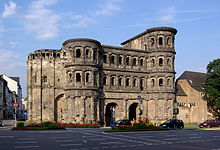Simeon of Trier
Saint Simeon of Trier (* around 980/990 in Syracuse , Sicily , † June 1, 1035 in Trier ) was a Byzantine monk who ended his life as a hermit . His feast day is June 1st.
Life
Simeon was born as the son of a Greek officer in Syracuse , which was then Muslim , grew up in Constantinople and was trained there. He served as a pilgrim guide in Jerusalem and Palestine for seven years . Then he spent two years as a monk in Mary's monastery in Bethlehem , later Simeon moved to St. Catherine's monastery on Sinai , where he wanted to prepare for his later life as a hermit.
He was sent by his abbot to the annual alms reception to Duke Richard II of Normandy . His ship was attacked by pirates, but he was able to save himself on the bank. Nevertheless, he continued on his way and on the way in 1026 joined the abbots Richard of St. Vanne and Eberwin of St. Martin (Trier), who were on their return journey from Jerusalem.
On his arrival in Rouen (1027), however, Duke Richard II had already died. Eberwin von St. Martin introduced him to Archbishop Poppo in the same year and it was decided that Simeon should accompany Archbishop Poppo of Trier on his pilgrimage to the Holy Land (1028-1030). After their return together, Simeon was solemnly walled up in the eastern tower of the mighty Roman city gate of the Porta Nigra in Trier at the St. Andrew's Festival in 1030 , in order to be able to live there in complete prayer as a hermit ( hermit ). According to popular belief, he was miraculous.
On his travels he covered about 25,000 kilometers. It was helpful that he spoke Greek , Egyptian , Arabic , Syriac and Romansh .
Archbishop Poppo and Eberwin von St. Martin caused after his death that he was already in December 1035 by Pope Benedict IX. was canonized. After Ulrich von Augsburg , Simeon was the second saint to be officially canonized. In 1041, Archbishop Poppo began to transform the Roman Porta Nigra into a church, thereby protecting the building from being used as a quarry like others in the Middle Ages. The Simeonstift was built next to the church, today the Simeonstift Municipal Museum . In 1400, Simeon's bones were solemnly raised. The Church of St. Simeon was the destination of local pilgrimages . In 1803, on Napoleon's orders, most of the medieval additions to the Porta Nigra were demolished in order to restore the overall Roman impression of the building.
The late baroque sarcophagus and the relics then came to the Church of St. Gervasius in Trier. Since 1971 there has been a (new) parish church of St. Simeon in Trier-West, to which the tomb and relics were transferred. A Greek lectionary (Codex Simeonis, 10th / 11th century) and a needle-tied cap of St. Simeon (according to tradition made of camel hair, but actually made of brown sheep's wool) are kept in the Trier Cathedral Treasury . Simeon's Greek Euchologion (Palestine, before 1030), from which Ambrosius Pelargus (Storch) translated the Chrysostomus liturgy into Latin in 1540: Divina ac sacra liturgia sancti Ioannis Chrysostomi , was only lost in modern times . Interpreter Ambrosio Pelargo Niddano, OP (Worms 1541).
In the east tower of the Porta Nigra, the so-called Simeonsklause is accessible, according to tradition the room in which the saint was walled in and where he died. Today there is a continuous multimedia presentation of his life.
gallery
St. Simeon, Church of Our Lady Trier , west facade
literature
- I. Heikkilä: Vita of S. Symeonis Treverensis. A high medieval cult of saints in context. Akad. Scient. Fennica, Helsinki 2002, ISBN 951-41-0925-2 .
- Franz-Josef Heyen : Simeon von Trier. In: Lexicon of the Middle Ages . Volume VII, Stuttgart 2002, columns 2184-2186.
- Bernd Kettet: Simeon von Trier. In: Biographisch-Bibliographisches Kirchenlexikon (BBKL). Volume 10, Bautz, Herzberg 1995, ISBN 3-88309-062-X , Sp. 366-368.
- Andreas Heinz: St. Simeon in the Porta Nigra in Trier. Life, wonder and adoration of a worldly hermit. Kliomedia-Verlag, Trier 2018, ISBN 978-3-89890-215-1 .
Web links
- Simeon von Trier in the Ecumenical Lexicon of Saints
- Trier personalities from 2025 years
- Website with a photo of the Simeons hat in the Trier Cathedral Treasury
Footnotes
- ^ Franz-Josef Heyen: Simeon von Trier. In: Lexicon of the Middle Ages . Volume VII, Munich 2003, columns 1911–1912.
- ↑ Sysse Gudrun Engberg: Trier and Sinai: Saint Symeon's Book. In: Scriptorium 59 (2005) 132–146 with plates 19–24.
- ↑ Regula Schorta: Biretum S. Symeonis. A medieval vestment relic and its covers. In: Michael Embach et al. (Ed.): Sancta Treveris. Contributions to church building and fine arts in the old Archdiocese of Trier. Festschrift for Franz J. Ronig on his 70th birthday. Trier 1999, pp. 609-624.
- ↑ Heribert Smolinsky: Ambrosius Pelargus, OP (1493 / 94-1561). In: Erwin Iserloh : Catholic theologians of the Reformation period. Vol. 4. Aschendorff, Münster 1987, pp. 75–96, here p. 90 ( (PDF; 2.3 MB) ; A. Strittmatter: Missa Treverensis seu Sancti Simeonis Syracusani. In: Studia Gratiana 14 (1967) 495– 518.
- ↑ Newspaper article in the Trierischer Volksfreund from July 5, 2015.
| personal data | |
|---|---|
| SURNAME | Simeon of Trier |
| ALTERNATIVE NAMES | Symeon Syracuse |
| BRIEF DESCRIPTION | Pilgrim guide and hermit |
| DATE OF BIRTH | between 980 and 990 |
| PLACE OF BIRTH | Syracuse in Sicily |
| DATE OF DEATH | June 1, 1035 |
| Place of death | trier |









